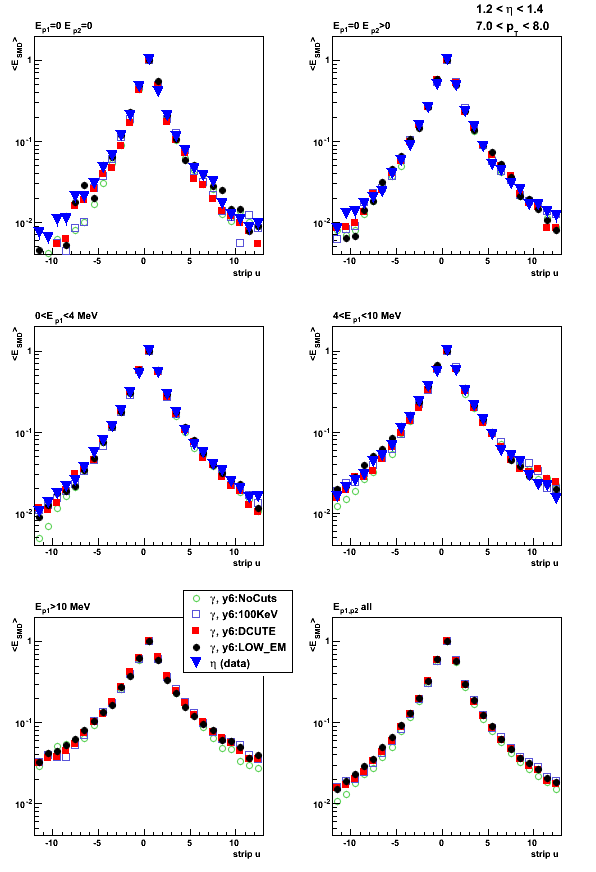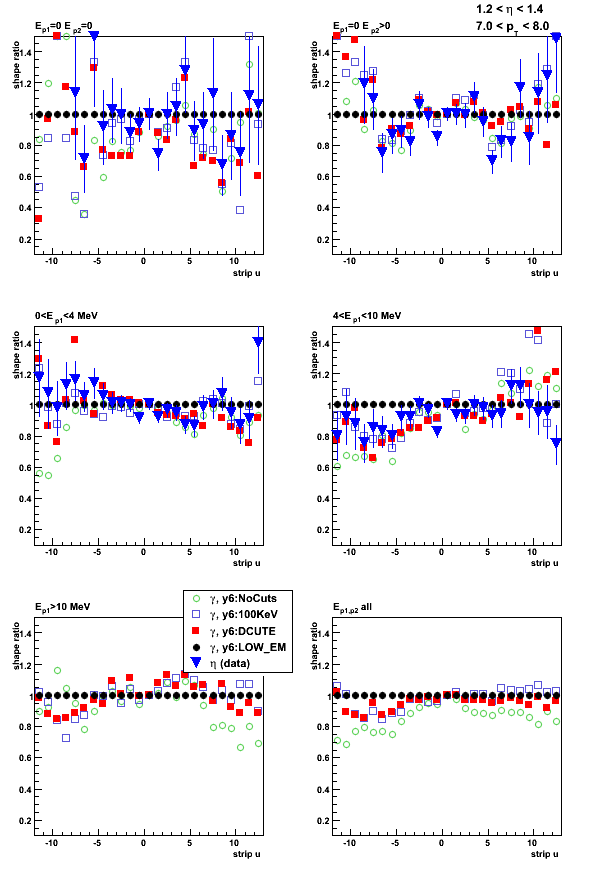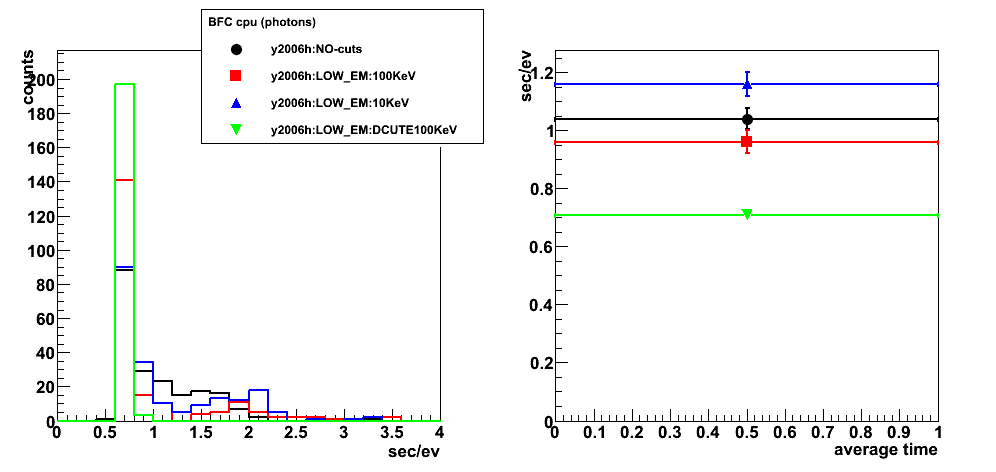12 Dec
December 2009 posts
2009.12.01 BEMC 1x1, 2x1, 2x2, 3x3 clustering
Monte-Carlo setup:
- Throwing one photon per event
- Full y2009 STAR geometry configurations with/without LOW_EM option
- Throw particles flat in eta (-1,1), phi (0, 2pi),
with energy: 30GeV with flat (+/-0.5 GeV) spread - bfc.C options:
trs,fss,y2009a,Idst,IAna,l0,tpcI,fcf,ftpc,Tree,logger,ITTF,Sti,MakeEvent,McEvent,
geant,evout,IdTruth,tags,bbcSim,tofsim,emcY2,EEfs,
GeantOut,big,-dstout,fzin,-MiniMcMk,beamLine,clearmem,eemcDB,VFPPVnoCTB - Use fixed (7%) sampling fraction in StEmcSimpleSimulator.cxx
mSF[0] = 1/0.07;
mSF[1] = 0.;
mSF[2] = 0.; - Vertex z=0
- 50K/per particle type
data base settings (same settings in bfc.C (Jan's trick) and in my MuDst reader):
dbMk->SetFlavor("sim","bemcPed");
dbMk->SetFlavor("Wbose","bemcCalib");
dbMk->SetFlavor("sim","bemcGain");
dbMk->SetFlavor("sim","bemcStatus");
Note: for BEMC ideal pedSigma set to 0, so effectively
there is no effect when I apply 3-sigma threshold above pedestal.
Figure 1: Energy sampling of various cluster in the Barrel EMC
E_reco is the total energy in the BEMC towers from mMuDstMaker->muDst()->muEmcCollection()
eta_thrown - rapidity of the thrown photon from the Geant record
Cuts: |eta| < 0.97 && |eta|>0.01 && total energy s.f. > 0.055
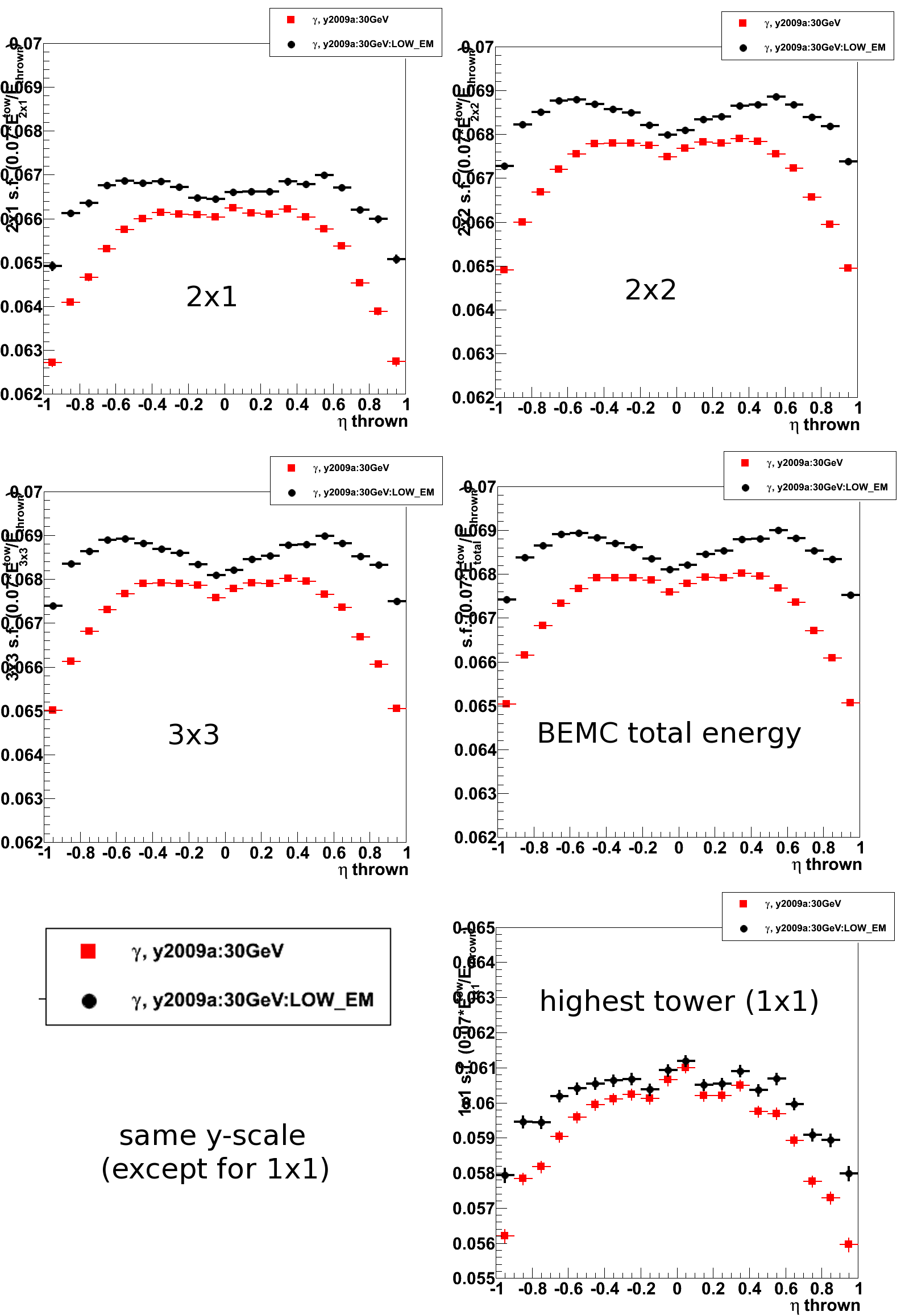
Figure 2: Various cluster energy ratios
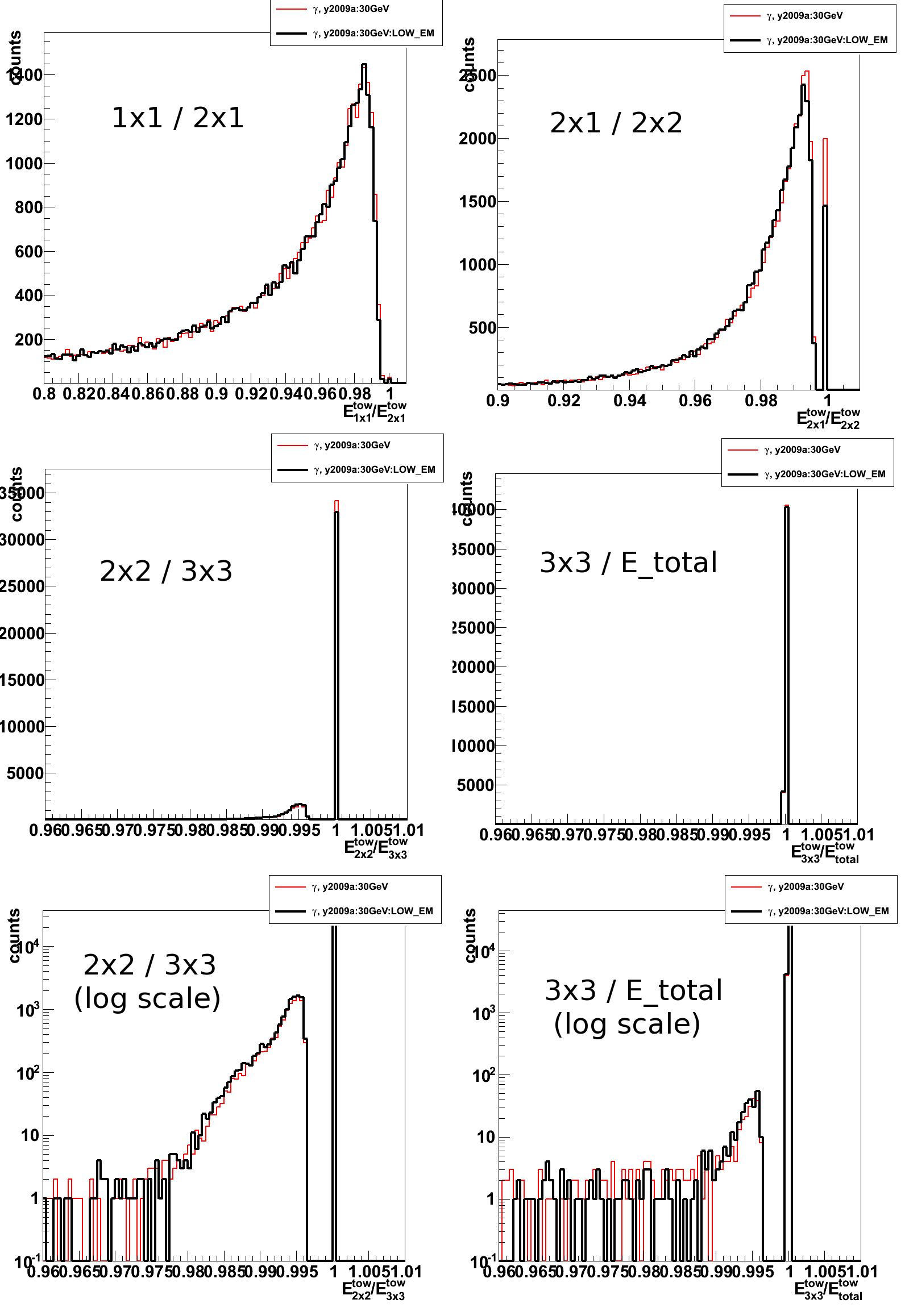
2009.12.07 Low EM study: LOW_EM option, 100KeV cuts, and DCUTE=100KeV
Conclusions/dicsussion at the emc2 hypernew
http://www.star.bnl.gov/HyperNews-star/get/emc2/3369.html
http://www.star.bnl.gov/HyperNews-star/get/emc2/3375.html
Monte-Carlo setup:
- Throwing one photon per event
- Full STAR y2006h (latest EEMC, v6.1 and TPC, v04 geometries)
- Throw particles flat in eta (1.08, 2.0), phi (0, 2pi), and energy (5-35 GeV)
- Using A2Emaker to get reconstructed Tower/SMD energy (no EEMC SlowSimulator in chain)
- Vertex z=0
- ~50K/per particle type
- Non-zero energy: 3 sigma above pedestal
GEANT EM cuts list (default values in GeV)
- CUTGAM - cut for gammas (GEANT default = 0.001)
- CUTELE - cut for electrons (GEANT default = 0.001)
- CUTHAD - cut for charged hadrons (GEANT default = 0.01)
- CUTNEU - cut for neutral hadrons (GEANT default = 0.01)
- CUTMUO - cut for muons (GEANT default = 0.01)
- BCUTE - cut for electron brems (GEANT default = CUTGAM)
- BCUTM - cut for muon brems (GEANT default = CUTGAM)
- DCUTE - cut for electron delta-rays (GEANT default = 10^4)
- DCUTM - cut for muon delta-rays (GEANT default = 10^4)
- LOSS - energy loss
- STRA - energy fluctuation model
- Birks law parameters (Tracking Parameters)
MODEL BIRK1; RKB BIRK2; C BIRK3
Low EM cut configurations (values in GeV)
-
NoCuts: Default STAR geometry EM cuts
Endcap EMC setup is quite non-uniform
(all cuts are set via "Call GSTPAR (ag_imed,'CutName', Value)":- Block EMGT: 30 degree megatile
CUTGAM = 0.00001
CUTELE = 0.00001 - Block ESCI: active scintillator (polystyrene) layer
CUTGAM = 0.00008
CUTELE = 0.001
BCUTE = 0.0001
CUTNEU = 0.001
CUTHAD = 0.001
CUTMUO = 0.001
c-- Define Birks law parameters
BIRK1 = 1.
BIRK2 = 0.013
BIRK3 = 9.6E-6 - Block ELED : lead absorber plate
CUTGAM = 0.00008
CUTELE = 0.001
BCUTE = 0.0001
CUTNEU = 0.001
CUTHAD = 0.001
CUTMUO = 0.001 - Block EALP: thin aluminium plate in calorimeter cell
CUTGAM = 0.00001
CUTELE = 0.00001
LOSS = 1.
STRA = 1. - Block EHMS: defines the triangular SMD strips
CUTGAM = 0.00008
CUTELE = 0.001
BCUTE = 0.0001
c-- Define Birks law parameters
BIRK1 = 1.
BIRK2 = 0.0130
BIRK3 = 9.6E-6
- Block EMGT: 30 degree megatile
- 100KeV: All cuts are set to 100KeV
CUTGAM = 0.0001
CUTELE = 0.0001
BCUTE = 0.0001
BCUTM = 0.0001
DCUTE = 0.0001
DCUTM = 0.0001 - DCUTE: All cuts are set to 10KeV, except electron delta-rays (DCUTE = 100KeV)
CUTGAM = 0.00001
CUTELE = 0.00001
BCUTE = 0.00001
BCUTM = 0.00001
DCUTE = 0.0001
DCUTM = 0.00001 - LOW_EM: All cuts are set to 10KeV
CUTGAM = 0.00001
CUTELE = 0.00001
BCUTE = 0.00001
BCUTM = 0.00001
DCUTE = 0.00001
DCUTM = 0.00001
Figure 1: Endcap EMC sampling fraction for different cluster sizes:
1x1, 2x1, 3x3, and total energy in the EEMC
Lower right plot shows total s.f. vs. photon thrown energy
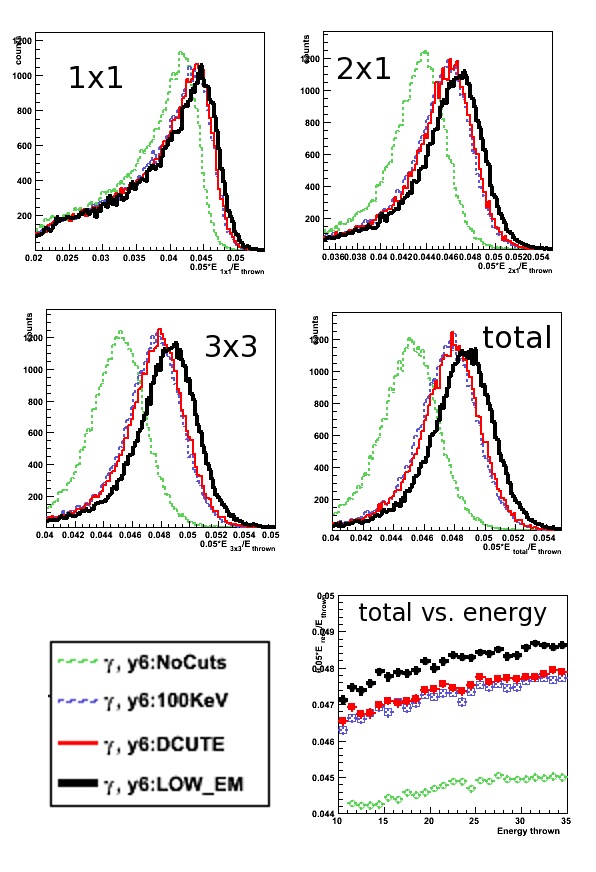
2009.12.08 Low EM timing study: 10KeV vs. 100KeV cut settings
Conclusions/dicsussion at the emc2 hypernew:
http://www.star.bnl.gov/HyperNews-star/get/emc2/3374.html
List of LOW_EM cuts and defaults
Low EM cut configurations (values in GeV)
- NoCuts: Default STAR geometry EM cuts
- LOW_EM:100KeV: All LOW_EM cuts are set to 100KeV
- LOW_EM:10KeV: (default) LOW_EM cuts (10KeV)
- DCUTE: All cuts are set to 10KeV, except for electron delta-rays DCUTE = 100KeV
QCD hard processes timing
Pythia QCD Monte-Carlo:
- Pythia pp@500GeV 2->2 hard QCD processes for parton pt>15GeV
- Full STAR y2009a (latest EEMC, v6.1 and TPC, v04 geometries)
- 50 events per file, 100 jobs
- BFC options and kumac details are here
Figure 1: QCD Total (GEANT/GSTAR+bfc) timing (seconds/event)
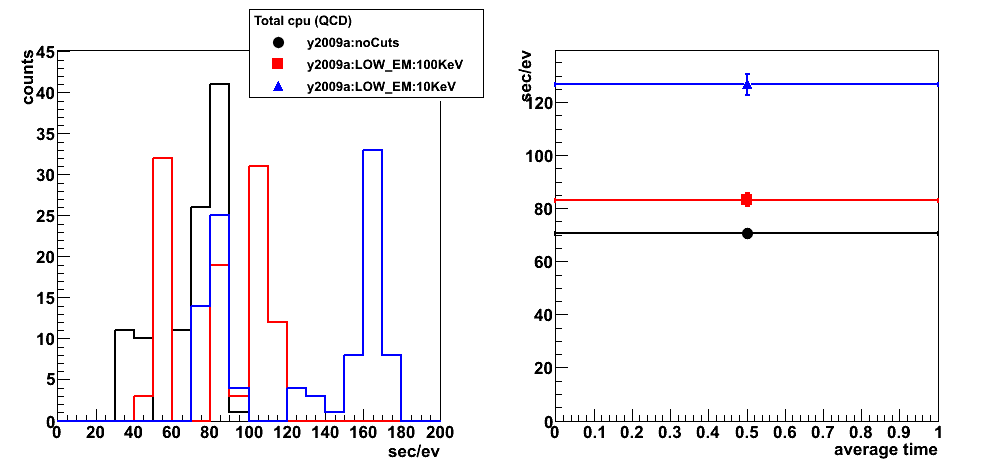
Figure 2: QCD GEANT/GSTAR timing (seconds/event)

Figure 3: QCD bfc.C timing (seconds/event)
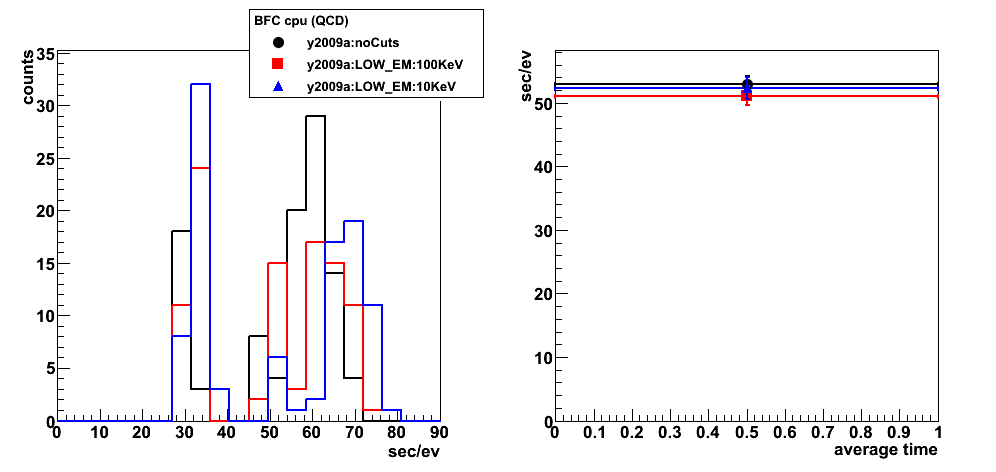
EEMC single photon timing
EEMC single photons Monte-Carlo
- One photon per event
- Full STAR y2006h (latest EEMC, v6.1 and TPC, v04 geometries)
- flat in eta (1.08, 2.0), phi (0, 2pi), and energy (5-35 GeV)
- 250 events per file, 200 jobs
Figure 4: EEMC single photon Total (GEANT/GSTAR+bfc) timing (seconds/event)
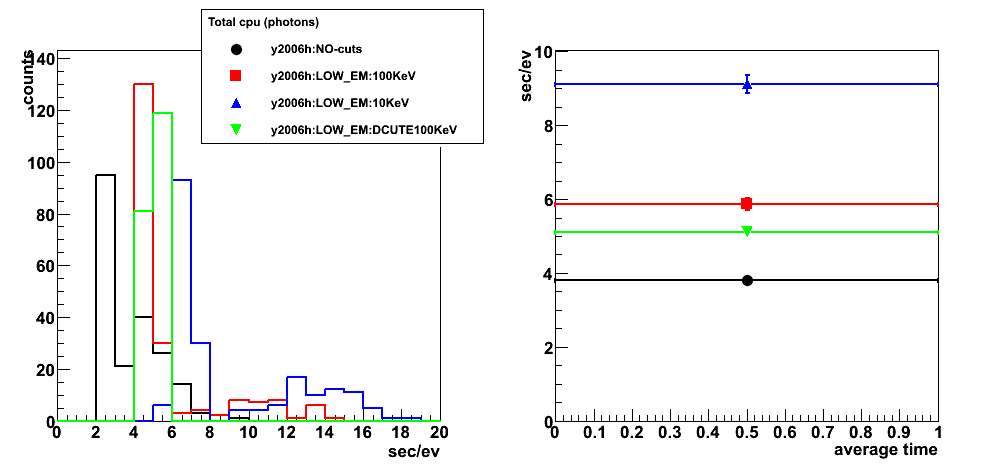
Figure 5: EEMC single photon GEANT/GSTAR timing (seconds/event)

2009.12.17 Ecalgeo-v6.2: embedded LOW_EM cuts in the calorimeter geometry
Monte-Carlo setup:
- Throwing one photon per event
- Full STAR y2006h (latest EEMC-v6.2 and BEMC with LOW_EM cuts, rest of geometry from CVS)
- Throw particles flat in eta (1.08, 2.0), phi (0, 2pi), and energy (5-35 GeV)
- Using A2Emaker to get reconstructed Tower/SMD energy (no EEMC SlowSimulator in chain)
- Vertex z=0
- ~50K/per particle type
- Non-zero energy: 3 sigma above pedestal
Figure 1: (left) Endcap EMC sampling fraction (total calorimeter energy), (right) SMD-u sampling fraction
Red: (previous) ecalgeo-v6.1 with global LOW_EM option
(Note: same points as in this post, Fig. 1 lower left, label y6:LOW_EM)
Black: (new) ecalgeo-v6.2 (embedded LOW_EM cuts), no global LOW_EM option
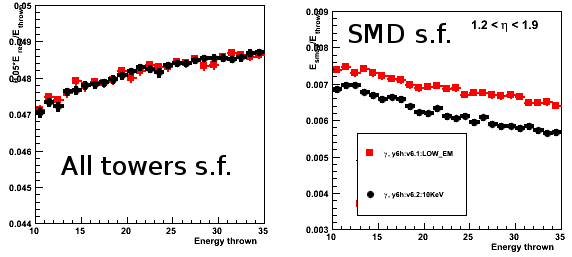
Figure 2: Pre-shower migrations
There is only a few events with pre1>4MeV with new simulations: potential problem with TPC geometry?
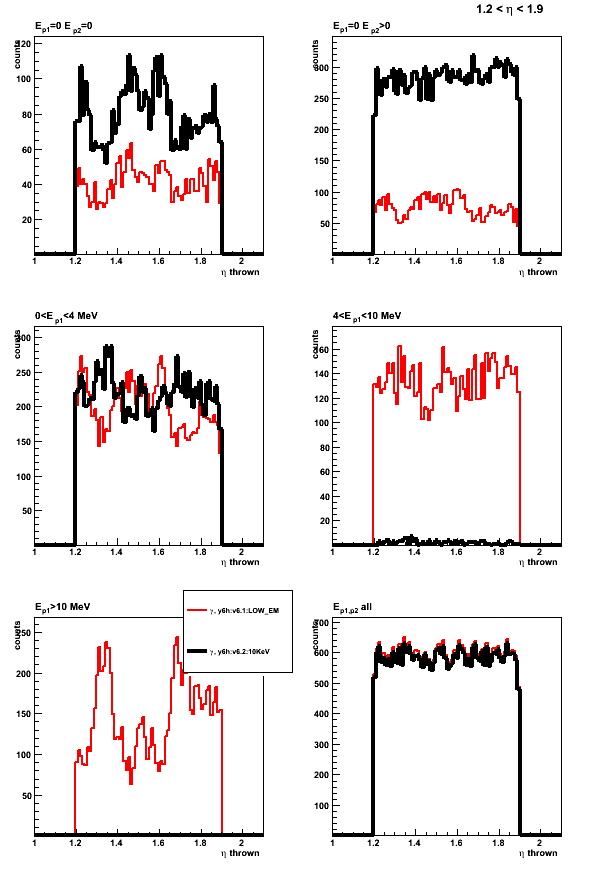
2009.12.20 Ecalgeo-v6.2: embedded LOW_EM cuts after TPC/EEMC overlap fix
Monte-Carlo setup:
- Throwing one photon per event
- Full STAR y2006h (latest EEMC-v6.2 and BEMC with LOW_EM cuts, rest of geometry from CVS)
- Throw particles flat in eta (1.08, 2.0), phi (0, 2pi), and energy (5-35 GeV)
- Using A2Emaker to get reconstructed Tower/SMD energy (no EEMC SlowSimulator in chain)
- Vertex z=0
- ~50K/per particle type
- Non-zero energy: 3 sigma above pedestal
Results: Update for the previous tests of EMC v6.2 geometry after fixing TPC/EEMC overlap
Figure 1: Endcap EMC sampling fraction: total calorimeter energy, pre1-, pre2-, post- shower layers, and SMD-u energy
Red: (previous) ecalgeo-v6.1 with global LOW_EM option
(Note: same points as in this post, Fig. 1 lower left, label y6:LOW_EM)
Black: (new) ecalgeo-v6.2 (embedded LOW_EM cuts), no global LOW_EM option
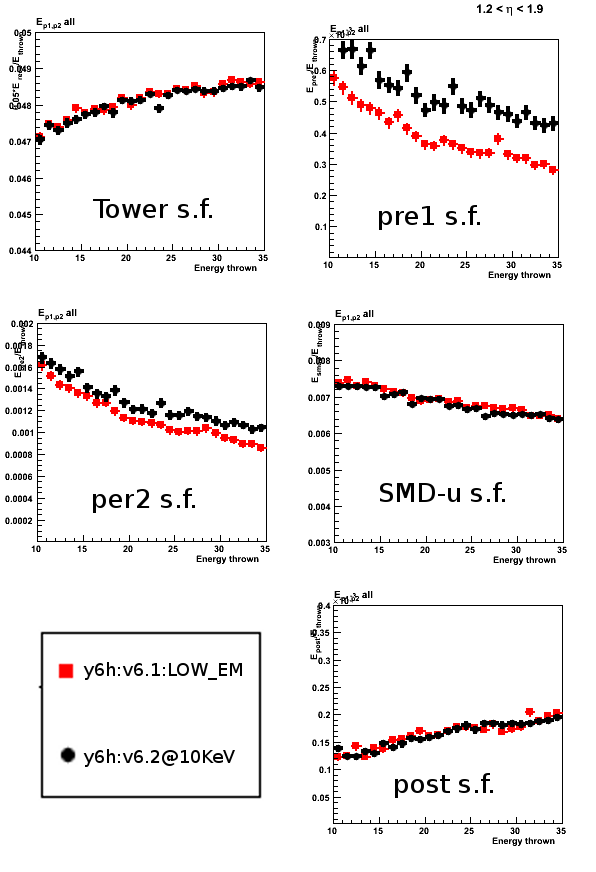
Figure 2: Pre-shower migrations
Change in TPC geometry seems to introduce a reasonable (small) change in pre-shower migration

Photon-jet simulation request
Simulation needs with y2006/y2009 geometry
specific to the photon-jet analysis
* Update version of the previous simulation
request from December 18, 2008 (see Ref. [1])
Understanding effects of trigger, material budget differences,
and throughout comparison between 2006 and 2009 data
requires to have dedicated Monte-Carlo
data samples with both y2006 and y2009 geometries.
Requested samples
We request to produce the following set of
Monte-Carlo samples for the photon-jet analysis:
- S1: 1st priority
Dedicated (gamma filtered, Refs. [2-5]) data sample
for Pythia pp@200GeV prompt photon processes
with y2006 STAR geometry configuration
and partonic pt range 2-25GeV.Simulations configured with:
-
LOW_EM option in starsim (Ref. [6]).
Low cuts on electromagnetic processes in GSTAR -
y2006h geometry tag, which includes
latest Endcap EMC (v6.1) and TPC (v4) geometry fixes. -
Pythia 6.4 CDF Tune A or Perugia tunes (6.4.22)?
-
- S2: 1st priority
Dedicated (gamma filtered, Refs. [2-5]) data sample
for Pythia pp@200GeV hard QCD processes
with y2006 STAR geometry configuration
and partonic pt range 2-25GeV.Same simulation setup as for the sample S1.
- S3: 2nd priority
Pythia pp@200GeV prompt photon and hard QCD
processes with y2009 STAR geometry configuration
and partonic pt range 2-25GeV.Same simulation setup as for the sample S1
but with y2009a geometry tag. -
S4: 3rd priority
Pythia pp@500GeV prompt photon and hard QCD
processes with y2009 STAR geometry configuration
and partonic pt range 2-25GeV.Same simulation setup as for the sample S1
but with y2009a geometry tag.
Event number, CPU time, and disk space estimates
Below I provide some estimates of CPU and disk space
which are required to produce the data samples listed above.
These estimates are based on the previous (private)
production of the MC gamma-filtered events with y2006
geometry which was done at MIT computer cluster
by Michael Betancourt (Ref. [2,4-5]):
- E1 (prompt photons)
Pythia pp@200GeV prompt photon simulations
with ~7 pb^-1 luminosity:-
~60 days running time on a single CPU
-
~17Gb of disk space to store MuDst/geant files
-
Number of (filtered) events:
~ 30K for pt range 6-9GeV
~ 15K for pt range 9-15GeV
-
- E2 (QCD hard process)
Pythia pp@200 QCD hard process simulations
with (at least) 1 pb^-1 luminosity:-
~ 620 days running on a single CPU
(less than a week on a cluster with 100 CPUs) -
~ 150Gb of disk space to store MuDst/geant files
-
Number of (filtered) events:
~ 650K for pt range 6-9GeV
~ 300K for pt range 9-15GeV
-
Notes on the estimates:
- N1
Enabling LOW_EM option in GSTAR increases
the time estimates by ~40% (Ref. [7]). - N2
Additional production of jet trees will
require a disk space on the order of < 2%
of the total size of the MuDst/geant files. - N3
Additional production of gamma trees will also
require a disk space on the order of a few percents
of the total size of the MuDst/geant files.
References
-
Previous simulation request (Date: 2008, Dec 18):
http://www.star.bnl.gov/HyperNews-star/protected/get/starspin/3596.html -
Michael's document on
"Targeted MC procedure for the gamma-jet program at STAR":
http://drupal.star.bnl.gov/STAR/system/files/20080729_gammaFilter_by_MichaelBetancourt.pdf -
simulations with filtering readiness:
http://www.star.bnl.gov/HyperNews-star/protected/get/starsimu/387/1/1/2/1/1/2/3/1.html -
Filtered photon production with y2006 geometry:
http://www.star.bnl.gov/HyperNews-star/protected/get/phana/256.html -
More details on statistics needed and disk space estimates:
http://www.star.bnl.gov/HyperNews-star/protected/get/phana/297.html -
LOW_EM option in GSTAR:
http://www.star.bnl.gov/HyperNews-star/protected/get/phana/371.html -
Time estimates with and without LOW_EM option:
